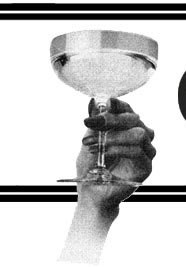 |
|
newsletter designer
Emerson University
Dan
Cook
editor
Rutgers University- Camden
George Ritzer
long-time, dedicated supporter
University of Maryland-College Park
Mike
Ryan
listserv manager
University of Maryland—College Park
Statement
of Purpose
The organizing
group for the Consumer Studies Research Network seeks to foster dialogue
and debate among those who are interested in and concerned about the
place of goods and commodities in social life. These interests and concerns
may range from the poetics of micro/personal identity formation to the
identity politics of gendered, raced and classed display, from historical
work on the rise of consumer culture to a critique of Nike advertising,
from investigations of typical places of consumption to the study the
dynamics of globalization and urban areas. Individuals affiliated with
the Consumer Studies Research Network desire to bring to the fore, in
their own ways, the depths to which commodities and a market logic have
come to pervade virtually all forms of social life and social interaction.
The primary goal is to begin to engage in an interchange.
Contact:
Dan Cook
Consumer Studies
Research Network
Rutgers University
405-7 Cooper Street
Camden, NJ 08102
phone: 856-225-2816
fax: 856-225-6435
dtcook@camden.rutgers.edu
Have something to say? Send in essays, comments, letters, reviews, observations
for the next Newsletter.
For
technical questions, please contact Monika
Deppen Wood
Karen Bettez Halnon
Pennsylvania State University
kbh4@psu.edu
While scattered examples of Poor Chic can be found historically in North America and Europe, the controversy of it, but never named generally as such, did not surface in any major way in public consciousness until the early 1990s.
Even during the 1970s, with the Sex Pistols' frontman
Johnny Rotten (named for his decaying teeth) singing about privileged
people taking a "holiday in other people's misery" and the
ironic subsequent fashion of torn up and tattered punk clothes (worn
by Rotten originally as necessity), poverty chic was still in a relative
state of immaturity.
It was not until the 1990s that public awareness
increased, with moral and aesthetic critics condemning Seattle’s “grunge” music,
with its “dirty” guitar sound and angst-filled lyrics, most
notable in the mainstream by Kurt Cobain’s band Nirvana that climbed
the charts in 1991, and by Pearl Jam, shortly thereafter.
 |
|
|||||
On Feminism in the Age of Consumption
Nicki Lisa Cole
University of California, Santa Barbara
Nickilcole@umail.ucsb.edu
Alison
Dahl Crossley
University of California, Santa Barbara
Acrossley@umail.usb.edu
“The largest growing economic force in the world isn't China or India -- it's women. The earning power of women globally is expected to reach $18 trillion by 2014 -- a $5 trillion rise for current income, according to World Bank estimates. That is more than twice the estimated 2014 GDP of China and India combined” (Voigt 2009)
The above quote from a recent article posted on CNN.com, titled “Women:
Saviors of the world economy?” reflects heightened attention to
both the earning power and spending power of today’s women. Economists,
product designers, and marketers are turning to women as the consumers
who can perpetuate capitalist growth in this post-economic crisis moment.
The FemmeDen, a group of women researchers who focus on the gendered
implications of product design, write in one of their online publications, “Why
is gender important? Women’s continuing evolution combined with
their increasing buying power has created an explosive business opportunity
in the consumer products industry.” They then point out that women
in the U.S., though once “powerless,” are now “powerful,” in
that they buy or influence eighty percent of consumer decisions (FemmeDen
2009a).
This heightened attention to U.S. women’s purchasing power
comes at a time when discourses that link women’s independence
to consumption abound in popular culture. Today’s television line-up,
heavy in “reality” programming
focused on celebrities and wealthy women, serves this intersection to
millions of viewers on an everyday basis. Wealth and the ability to consume
are routinely celebrated and held up as exemplars of the most current
iteration of the American Dream, which today is illustrated as a lifestyle
display rather than a particular set of achievements.
by Karen Rafferty
Dublin Institute of Technology
karen.rafferty@dit.ie
In the last couple of decades, transformations in the fashion industry and marketplace have ignited debate about the nature of social class relations today. Fashion writer Dana Thomas (2007) illustrates how, since the mid 1980s, many luxury fashion houses passed brand management from the family kin to external CEOs, who started to aggressively target the mass, and primarily middle class, markets. This move was to alter the intrinsic nature of the industry, having been centred upon visually differentiating the elite from subordinate classes for hundreds of years. In the pursuit of expanding profit, quality and craftsmanship were compromised so lower-priced product lines could make the point of entry for luxury fashion consumption more accessible across class fractions.
